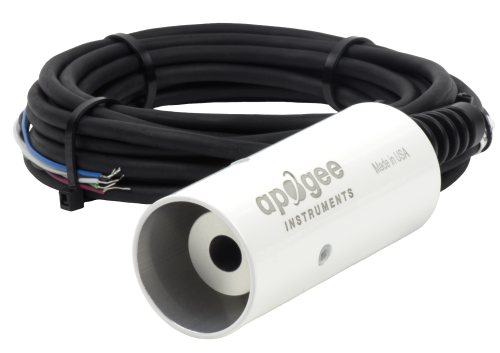该产品不再可用,已被以下内容所取代:Si-111ss.。

| 可用服务 |
|---|
Overview
由Apogee制造的Si-111是一种精密红外辐射计,用于确定物体的表面温度而没有物理接触。它测量受试者的表面温度和传感器体温。坎贝尔科学数据记录器使用这些测量来计算主题的正确温度。
阅读更多Benefits and Features
- 兼容的with most Campbell Scientific data loggers
- Measures surface temperature continuously in the field
- Provides road surface, plant canopy, soil surface, snow surface, and water surface temperature measurements
- 避免影响温度,提供更准确的测量
- 非常适合提供空间平均值
- 坚固的建筑 - 两个温度探头,含有锗窗户的铝体
图片






Detailed Description
Si-111由热电堆,测量表面温度和热敏电阻,测量传感器体温。两个温度传感器容纳在含有锗窗口的坚固型铝体中。
热电堆和热敏电阻输出一个millivolt signal that most of our data loggers can measure. The data logger uses the Stefan-Boltzman equation to correct for the effect of sensor body temperature on the target temperature. The corrected readings yield an absolute accuracy of ±0.2°C from -10° to +65°C.
视野(FOV)
Si-111具有22度的半角视野(FOV)。将FOV报告为由目标(锥形基底)和检测器(锥形顶点)形成的锥体顶点的半角。目标是圆的圆,来自该循环从该圆形被发射检测器观察的辐射。
注意:在2008年11月之前,SI-111被命名为IRR-p。
规格
| 输入功率 | 2.5 V励磁(热敏电阻) |
| Response Time | <1 s(目标温度的变化) |
| Target Temperature Output Signal | 60μV/°C与传感器体的差异 |
| Body Temperature Output Signal | 0 to 2500 mV |
| 光学 | 锗镜头 |
| Wavelength Range | 8至14μm(对应大气窗口) |
| 视野(FOV) | 22°半角 |
| 工作温度范围 | -55°至+ 80°C |
| 操作相对湿度范围 | 0 to 100% RH |
| 电缆描述 | 4.5米(14.76英尺)扭曲,带有Santoprene套管的屏蔽4导线,结束尾纤 |
| 绝对准确性 |
|
| 均匀性 |
|
| Repeatability |
|
| Diameter | 2.3 cm (0.9 in.) |
| 长度 | 6厘米(2.4英寸) |
| 重量 | 190 g (6.7 oz) |
兼容性
笔记:The following shows notable compatibility information. It is not a comprehensive list of all compatible or incompatible products.
数据记录器
| 产品 | 兼容的 | 笔记 |
|---|---|---|
| 21X(退休) | ||
| CR10(退休) | ||
| CR1000(退休) | ||
| CR10X.(退休) | ||
| CR200X(退休) | ||
| CR206x.(退休) | ||
| CR211X(退休) | ||
| CR216x.(退休) | ||
| CR23x.(退休) | ||
| CR295x.(退休) | ||
| CR300 | ||
| CR3000 | ||
| CR310 | ||
| CR500(退休) | ||
| CR5000(退休) | ||
| CR510(退休) | ||
| CR6 | ||
| CR800. | ||
| CR850 | ||
| CR9000(退休) | ||
| CR9000X(退休) |
Additional Compatibility Information
Mounting
The SI-111 is often fastened to a CM200-series crossarm, a tripod or tower mast, or a user-supplied pole using a CM230, CM230XL, or CM220 mount. The CM230 and CM230XL are adjustable inclination mounts that allow the SI-111 to be mounted perpendicular to the target surface when the target surface is on an incline. The CM230XL is similar to the CM230, but the CM230XL places the SI-111 further from the pole or crossarm. The SI-111 may also be attached directly to a user-supplied camera tripod.
Documents
经常问的问题
与之相关的常见问题解答数量SI-111:8.
Expand AllCollapse All
-
The window in the Apogee infrared sensor is inset and protected, but it can become partially blocked in three ways:
- 蜘蛛可以在入口处筑巢。Campbell Scientific建议使用棉花拭子涂抹在孔径入口处的蜘蛛驱蚊器。但是,请勿将驱动剂应用于传感器窗口本身。
- Calcium deposits can accumulate on the window if irrigation water sprays up on the head. These deposits typically leave a thin white film on the surface, which can be removed with a diluted acid, such as vinegar. Calcium deposits cannot be removed with solvents such as alcohol or acetone.
- In windy environments, dust and dirt can be deposited in the aperture. The aperture can be cleaned with deionized water, rubbing alcohol, or in extreme cases, acetone.
使用蘸在适当溶剂中的棉花拭子清洁内线和传感器窗口。F或其他清洁信息,查看维护部分说明书。
-
There are two accuracy specifications listed for the SI-111:
- 当目标和传感器体温差异小于20°C时(更准确)
- 一个用于当目标和传感器体温的差异大于20°C时(较少准确)
Using a radiation shield with the sensor helps keep the sensor body temperature in close approximation to the ambient air temperature. Ultimately, the need to protect the sensor from short-wave radiation is dependent on what is being measured and under what conditions. For example, Campbell Scientific recommends using a radiation shield for canopy measurements.
-
As a general recommendation, recalibration should be done every two years.
-
SI-111已成功校准,最大电缆长度为100米,无需损失。理想情况下,传感器通过已配置的整体电缆长度校准。然而,我们的测试表明,在该领域中添加了几米的电缆对校准具有可忽略的影响,只要测量装置具有显着高的输入阻抗,例如CR1000。
-
The SI-111 can be used to measure a wide variety of surfaces, including water and snow. When measuring objects with low emissivity, however, it is particularly important to apply corrections to the measurement.
-
包括在校准片上的信息与每个传感器不同。对于某些传感器,纸张包含编程数据记录器所需的系数。对于其他传感器,校准表是通行/失败报告。
-
This depends on the information contained in the calibration sheet:
- If the calibration sheet contains coefficient information, Campbell Scientific keeps a copy, and a replacement copy can be requested.
- If the calibration sheet does not contain coefficients, Campbell Scientific does not keep a copy. It may be possible to contact the original manufacturer for a replacement copy.
-
Because of the loss of IR radiation, nearly all thermopile instruments typically have a negative offset. This offset is most easily visible at night-time, when a small negative value is read instead of zero. This same offset is present during the daytime, but it is not as visible because of the large solar signal.
另一个常见问题涉及练习仪器。调平热电型仪器可能导致直梁部件中的误差,因为余弦响应不正确。当太阳靠近地平线时,这些错误更值得注意,因为角度如此浅。
实例探究
The Problem—How to optimize green-roof performance The University of Toronto's Green Roof Innovation Testing Laboratory (GRIT......read more
Networks using the ALERT protocol are designed to give immediate access to data that indicates......read more
The cultivation and export of roses and other flowers is a huge business in Colombia.......read more
文章和新闻稿
博客文章
-
使用直接测量最小化霜冻的损失

02-08-2017Author: Dirk Baker
Privacy Policy Update
我们更新了我们的隐私政策。了解更多



